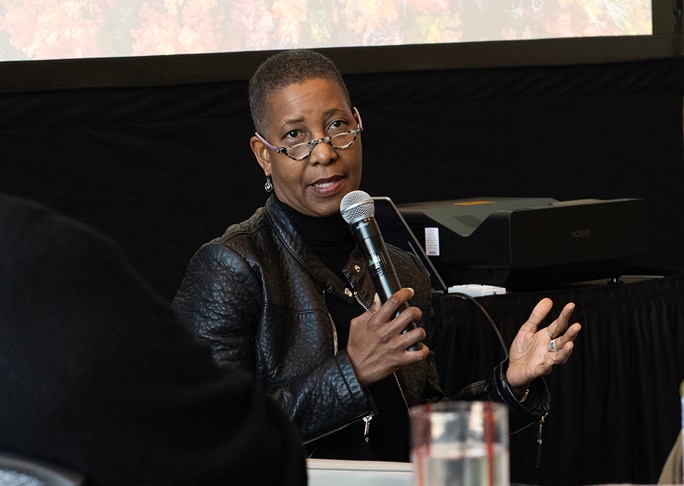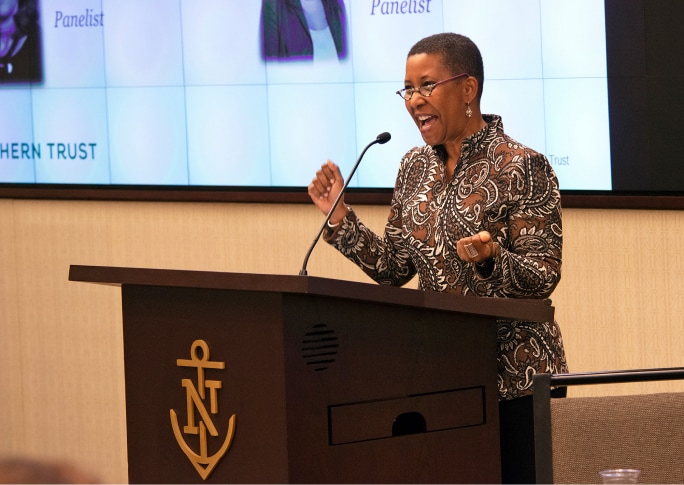By Jessie Sardina, Contributor
You could say Marguerite Griffin is gifted in the art of giving. As Northern Trust’s Director of Philanthropic Advisory Services, she helps her clients bring their philanthropic vision to life by managing charitable trusts and private foundations, facilitating family philanthropy retreats, and creating strategic philanthropy plans for multigenerational families.
Throughout her more than 32-year career, she has witnessed a dramatic shift in the philanthropic landscape — from male-dominated boards and conventional giving vehicles, to a new era of innovative, women-led giving strategies. Learn about her unique reflection on the changing landscape of philanthropy, her perspective on the state of women and giving today, and her advice for women looking to get involved in the movement.
Marguerite, clearly this work is something you are passionate about. What is your personal connection to philanthropy?
My start in philanthropy came when I was in grammar school, and our church hosted the annual trick-or-treat for UNICEF drive. For Halloween we’d go around with these little orange boxes and collect quarters for children in another part of the world. Realizing that, by asking people for donations, I could improve the lives of children in another part of the world was life-changing. That is when the power of charitable giving really started to make sense to me.
Over the years, I’ve learned that being of service to others can make for a meaningful life. I don’t know if you’re familiar with the term ikigai? It’s a Japanese philosophy that encourages an individual to explore the intersection between doing something they're good that, that they enjoy, that supports their family and lifestyle and adds value to the world — all these things come together to create their ikigai. It is what everyone wishes for in their life, to be able to find work that feeds them and feeds the world at the same time. I feel fortunate to have found my ikigai in the work I do.
Thinking about ways that I can help others who are passionate about giving is what gets me up every morning. There is nothing like working with a client who wants to give, and help them manage the transition to ‘I’ve got enough for myself, so now I want to give to others.’ That’s an amazing transition to witness, and to be able to help guide them as they shift from consumption to giving, I feel a huge privilege and honor to be able to meet them in that place. So that’s what gets me going and keeps me interested in this field.
In your view, how has the landscape of philanthropy evolved over the years for women?
Twenty-five years ago, I was the youngest person on a panel at the Women’s Board at the Chicago Symphony Orchestra. Every woman who was at that luncheon was referred to as ‘Mrs. Husband’s Name’ — it seemed to me that their roles as philanthropists were defined as merely representatives of their husbands. I was the last speaker, and began my remarks by saying: ‘When women fully understand the power they have to direct and shape philanthropy and begin to use that power, it will be the next women’s revolution.’ It was immediately and unnervingly quiet, as if everyone was thinking ‘I can’t believe she just said that!’ But today, when you think about the philanthropy of MacKenzie Scott and Melinda French Gates — it's clear that these women, and many others, have revolutionized how philanthropy gets done. Back then, most women participated in philanthropy by supporting the issues that were important to their husbands — they maintained the status quo. The women at that luncheon may have been pleased just to be allowed in the dining hall. Today, women are often the primary decision-makers when it comes to directing their families' charitable dollars; they are defining the rules and strikingly command the rooms where they find themselves in quiet, unique, small and big ways.
This reminds me of a recently-widowed client who asked me, ‘Should I continue to support the organizations that he (i.e. her deceased husband) supported?’ When I told her that she could give to whichever organizations she wanted, it sparked something in her, and she spent the rest of her life being her own kind of philanthropist. So, being able to unlock resources and provide strategic advice to drive those resources toward impact and create the change that women want is really exciting and personally and professionally fulfilling.



Tell us about some of the other trailblazing you see in the world of philanthropy.
I think there is something really powerful about women in leadership roles — both within traditional philanthropic spaces like boards and nonprofits, as well as at the helms of for-profit corporations and businesses. In my experience, female CEOs of for-profit businesses are often leading with a focus on the bottom-line and the impact their businesses are having on their communities. Kendra Scott comes to mind as a great example of a female-founded company, where giving back is at the core of their business. From the very beginning, she has been focused on uplifting the communities in which her jewelry stores are based. Today, she continues to reflect that focus through her philanthropic foundation, as well as her work leading the Kendra Scott Entrepreneurial Leadership Institute at the University of Texas at Austin, where she is focused on nurturing the success of other female entrepreneurs.
And the power that women have extends beyond the for-profit or nonprofit institutions they may lead. Women are inheriting and building wealth, living longer than men and, as a result, often feel a sense of urgency regarding how and for what purposes the family's wealth is deployed. Indeed, now and in the future, women will have many more opportunities to step into their power and chart new and more expansive legacies that will enhance the lives of generations to come.
If I think about the clients I’ve worked with as a practicing attorney and during my career at Northern Trust, the individuals that have been the most interesting to work with have been the women who find themselves with a level of wealth they never imagined they would control. They are the ones who are willing to take risks. I think that’s an important quality to have in philanthropy. I’m inspired by the women who are willing to be bold and state what is important to them. These women also recognize the influence they have as a role models, whether it be in their secular and spiritual communities, within their families, as business leaders or CEOs of nonprofit oganizations, and among their peers, both male and female.



What do you think is the biggest opportunity for women in philanthropy?
Anyone who would like to make charitable gifts to help improve the lives of others might also want to imagine themselves as the receiver. So much of giving these days is very donor-centric. Many giving decisions are informed by what the donor’s goals are. But when you shift your thinking to how the gift may affect the receiver, this perspective brings with it curiosity, gratitude, humility and openness that I believe is essential to efficient and effective philanthropy. The key is to think about what the ‘perfect gift’ is — that is, a gift that holds space for both the donor’s goals and interests, and the receiver’s aspirations and needs.
Another opportunity that women have in the world of philanthropy is to use it as a conduit to engage younger generations. Getting involved in philanthropy can be a fantastic avenue for rising generations to learn and gain practical experience in evaluating charitable organizations and social enterprises — especially when they have the autonomy to choose how and to whom they want to give, even if it’s different than their families’ philanthropic goals. When a child understands that they can have different interests, different passions, and the family is going to support them in any event, that is a really powerful opportunity to build confidence and skills, and find their voice amongst their peers and the larger communities that will influence their development as individuals.
What is your advice to women who are interested in philanthropy but don’t know where to start?
Giving can be complicated and complex, yet also simple — you just have to think about expanding your notion of what it means to give. Giving can mean not just the giving of your financial resources, but also of your time. Start with where you are, what you know, and what’s important to you. Whether it’s volunteering or making gifts to your favorite charities, what you will find is that once you get involved and build connections with the causes and organizations that are important to you, the best way to make a positive and sustainable impact will become more clear. Consider partnering with other women who have similar passions and participate in collective giving to maximize your impact. One way to do this is by joining what’s called a “giving circle.” This can be a group of parishioners at your place of worship, or a group of civic leaders at your local community foundation, or a standalone entity such as Women Moving Millions. According to a recent report published by the Dorothy A. Johnson Center for philanthropy, the giving circle and collective giving movement has grown rapidly. Between 2017 and 2023, nearly 4,000 groups comprised of approximately 370,000 philanthropists (with 60% of groups entirely composed of women) donated more than $3.1 billion to causes. This movement is expected to double again in the next five years.1 It’s important to note there are various entry points for participation. For example, there are giving circles that allow women to come together to learn about an issue and pool their resources for as little as $5,000. You don’t have to have millions to give in order to participate in collective giving, and there’s tremendous power to affect change when a group of like-minded individuals come together to support what matters most to them. There are likely giving circles in your community with which you can connect fairly easily.
What do you think the future holds for the landscape of women and philanthropy?
Over the years, there has always been a comparison between how women differ from men in their giving. It’s my belief that women are becoming the standard bearers for philanthropy, and in the future, we’re going to be seeing more studies that are trying to capture what men are doing in relationship to women. When I think about what makes what MacKenzie Scott and Melinda French Gates are doing unique, it’s not just how they are doing it — giving the grantee more say through trust-based philanthropy and participatory grant making — it’s the fact that they are choosing the issues and how they are going to address those issues with a combination of philanthropy and private equity investments. This approach of giving is unique because it seeks to change the relationship among donors, nonprofit organizations and communities to shift power and move decision-making out of the hands of solely the donor and into the community. This is done through collaborative work and deep relationship building with organizations and communities, ultimately allowing them to determine how best to use resources given to them. I believe this approach, championed by MacKenzie Scott and Melinda French Gates, may become the model of what we think about when we ask ‘what is philanthropy?’
Learn more about Marguerite's work and our Philanthropic Advisory Services.
- Loson-Ceballos, A., & Layton, M. D. (2024). In abundance: An analysis of the thriving landscape of collective giving in the U.S. Dorothy A. Johnson Center for Philanthropy at Grand Valley State University and Philanthropy Together. https://johnsoncenter.org/wp-content/uploads/2024/04/in-abundance-an-analysis-of-the-thriving-landscape-of-collective-giving-in-the-u-s.pdf
